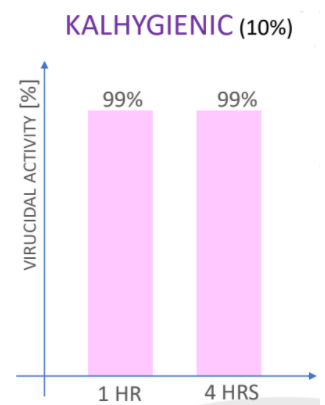Enhanced TDS
Knowde-enriched technical product data sheet
Identification & Functionality
- INCI Name
- Cosmetic Ingredients Functions
- CAS No.
- 1306-06-5
- EC No.
- 215-145-7
- Technologies
- Product Families
Features & Benefits
- Benefit Claims
- Labeling Claims
- Biomimetic Hydroxyapatite Functionalized with Cationic Surfactant (QAC)
Technology based on the use of the HAP, a remineralizing active, also acting as delivery system able to deliver a hygienizing surfactant in the oral mouth through a time controlled kinetics (4 hours)
- International patent
- Hygienizing active for toothpaste and mouthwashes: remineralizing HAP active vs biological agents.
- Long lasting bio-protection against infectious agents.
- Single application protects oral mouth up to 4 hours.
- Proven activity vs Bacteria and Viruses (including S. Mutans and Coronavirus)
- Local microbiota respectful
- Meet The Need: Our Innovative Proposal
Innovative cosmetic ingredient for the “New Normal” to boost your post pandemic oral care and personal hygiene protection.
- Stoichiometric Vs Biomimetic Hydroxyapatite
Biomimetic hydroxyapatite Stoichiometric hydroxyapatite Lower crystallinity degree Higher crystallinity degree Adapted morphology, optimized
for tooth adhesionLow adhesion to tooth surface Higher reactivity Lower reactivity Higher bioactivity Lower bioactivity Optimized release of incorporated actives Very slow release of incorporated actives Long lasting tooth remineralization Poor remineralizing action - Cationic Surfactant- Quaternary Ammonium Compound (QAC)
Protective: Works as cationic surfactant by impacting biological walls and membranes of microorganisms and keeping the skin clean.
Preventive: Promotes inactivation of viruses and bacteria by destroying the viral envelope or bacterial membrane (this mechanism of action does not induce resistance selection)
Safe: Widely used in cosmetics and food as preservative and contained in oral care products, it possesses an optimal safety profile.
- Benefits of Kalhygienic in Oral Care
Kalhygienic:
- Ensures a long-lasting effect by gradually releasing active concentrations of QAC in the mouth following a pH dependent kinetics.
- does not alter the composition of the normal oral flora.
- QAC does not allow potentially pathogenic bacteria in the mouth*
- QAC Reduces the production of volatile sulfur compounds (VSCs) by oral bacteria thus could reduce halitosis**
Oral Care Claims:
- Deep and long-lasting protection
- Bio-protection barrier against harmful germs
- Reduction of tooth sensitivity
- Enamel remineralization
- Prevention of bad breath (reduction of microorganisms causing bad odors)
- Caries prevention
- Microbiota respectful
- Anti-bacterial
- Reduction of plaque and tartar build-up
- Prevention of gum inflammation
* Radford et Al. 1997
** Liu et Al. 2013
Applications & Uses
- Markets
- Applications
- Application Format
- Oral Care Applications
- Application Fields
Microbiota care:
Human microbiome, previously referred to as human microflora, or human bacterial flora, has been known for decades. Microflora, or as we now call it more precisely microbiota, is in fact the assemblage of the commensals microorganisms present in a defined environment. Former approaches to Microbiota were not reproductible or had a very low specifity, making all the formulation efforts useless.
Kalichem’s Microbiota ingredients are very effective, bacteria free, formulator friendly ingredients, taking care of our Microbiota.Oral Hygiene:
Oral hygiene is the practice of keeping one’s mouth clean and free of disease and other problems (e.g. bad breath) by regular brushing of the teeth (dental hygiene) and cleaning between the teeth. It is important that oral hygiene be carried out on a regular basis, to enable prevention of dental diseases and bad breath. Kalichem’s biomimetic actives, with the support of Kalichem’s mild surfactants, will help prevent diseases and maintain a correct oral hygiene.
Technical Details & Test Data
- Product Innovation Trends
Need of Oral Care Products Able to Ensure Hygiene:
At Emergency time oral care products are able to ensure hygiene.It contains ingredients to:
- Extend the protective activity
- Form alcohol-free product
- Reduce sensitivity and strengthen teeth
- Biomimetic HAP as QAC Controlled Delivery System
Sugars are metabolized by bacteria thus producing acids that decrease pH - Stephan’s curve describes the variation of pH in the mouth after a meal
- When used in oral care formulations (mouthwashes, toothpastes, dental gels, etc.) kalhygienic settles on tooth enamel and slowly releases QAC.
- Decrease of pH in mouth after a meal promotes the release of QAC from HAP.
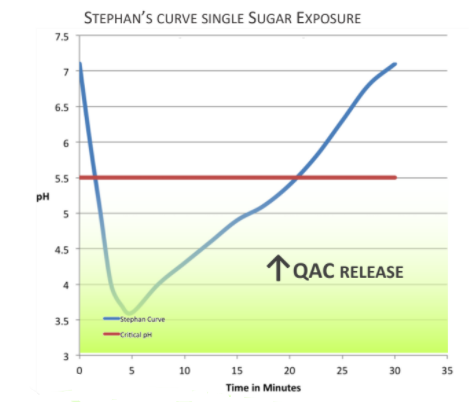
- Biomimetic Hydroxyapatite Deposited on Tooth
Remineralizing & Anti-hypersensitivity Action:
Kalident biomimetic HAP acts as a filler, by restoring minute cracks and scratches on tooth surface; its deposition allows to form a physiological reservoir that boosts in long term and ‘’on demand’’ the remineralization of scratches and lesions.
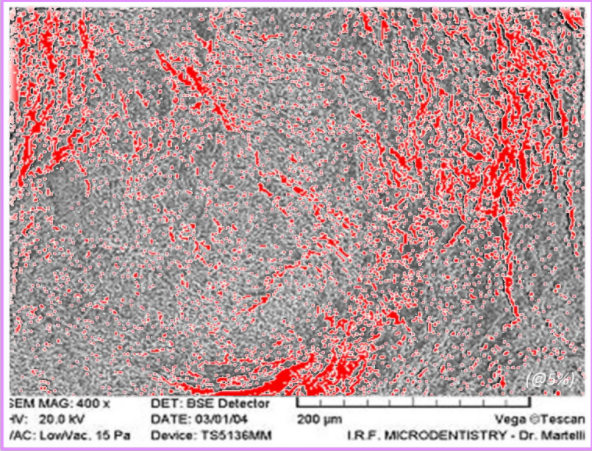
- Kalichem’s Tests: Efficacy of Kalhygienic
Ref: Test Type Properties Time Target Microorganism % of Use Functionalized Biomimetic
HydroxyapatiteTransmission Electron Microscopy
Activity on Bacterial Morphology
and Viral Envelope1 hr
Streptococcus Mutans 10%
Coronavirus 4 hrs
Streptococcus Mutans Coronavirus Cationic Surfactant
Quaternary Ammonium CompoundInfectivity Assay (PREN 14476:2011)
Virucidal
Activity1 hr Coronavirus 4 hrs - Activity of Kalhygienic Vs S. Mutans
Functionalized Biomimetic Hydroxyapatite Transmission Electron Microscopy (EM) studies showed that:
- Kalhyhienic (10%) works efficiently in deeply altering the morphology of streptococcus mutants (responsible for dental cavity)
- After 4 hours the alteration results still very evident.
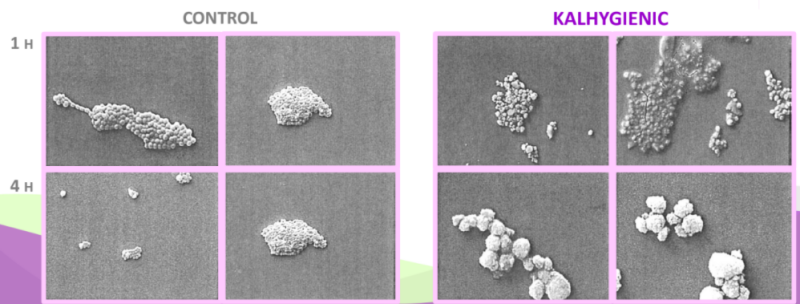
S. Mutans undergoes a deep alteration in its morphology; membrane becomes rough and shape irregular.
- Activity of Kalhygienic Vs Coronavirus
Functionalized Biomimetic Hydroxyapatite Transmission Electron Microscopy (EM) studies showed that:
- Kalhygienic (10%) works effectively in disrupting viral envelope of a selected strain of coronavirus after 1 hour treatment.
- After 4 hours alteration results significantly increased.
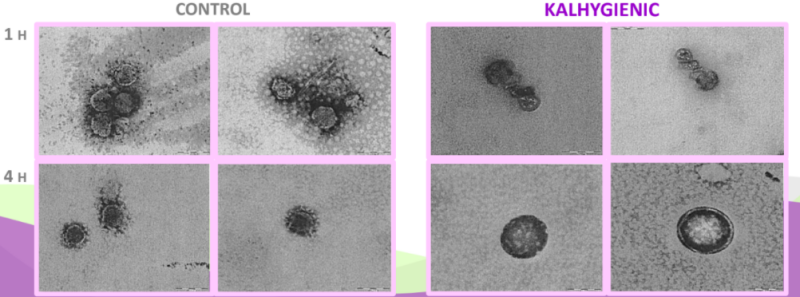
Intact virus undergoes a deep alteration in morphology leaving debris and expandend round structures.
- Infectivity Assay Vs Coronavirus
Cationic Surfactant Quaternary Ammonium Compound: Evaluation of Virucidal Activity according to European norm PREN 14476:2011. The assay allows to evaluate the ability of the test substance to inhibit growth and replication of viral particles in target cells
Test: Ability to reduce replication of a selected strain of coronavirus in cells after 1 hour and 4 hours treatment respectively. Viral particles were titred by using karber method.
